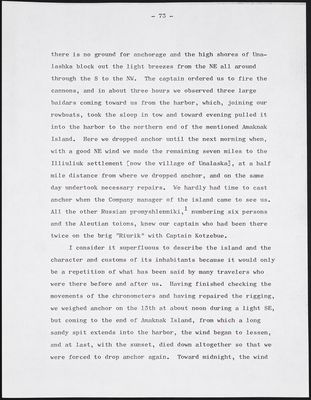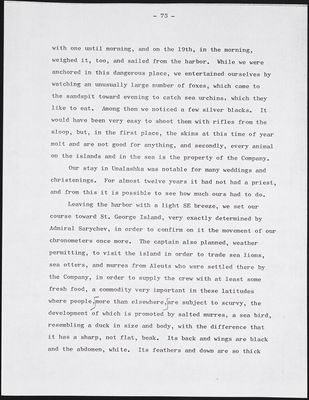Pages
mss142-vasilevShishmarev-i3-021
-- 71 --
rejoining the sloop, and his having to go directly to Unalashka,a distance of 40 miles from Bogoslof Island; and taking a map of the Kamchatka Sea, a compass, a chronometer, a sextant, and the log, they left at six-o'clock in the morning. Toward nine o'clock they approached the island, and rounding its eastern end, disasppeared behind it. At ten o'clock the previously quiet SE changed to a NE and brought a thick fog. The situation of our tender became very unpleasant. We, on our side, used all possible means to lead it out of this predicament. We came closer to the island, lay to, and started to beat the drums, to ring the bells, and fired the cannons every ten minues to indicate our position to him. But as these means are very inexact near high shores, and the noise reflecting from them may be heard from various sides, the captain decided to remain lying to until the clearing of the fog, and after that, to take measures suitable for the situation. The fog began to lift about three o'clock, and we saw our tender coming directly toward us, and in one hour it joined us.
Lieutenant Lazarev reported that, before the fog, they came so close to the island that they could have landed on the long low sandspit extending from the eastern end almost a mile into the sea if they had not been prevented by an infinite quantity of sea lions settled down on it. It is very dangerous to approach these sea monsters when they are on land. The sea lion attacks people when they bar his way to the water, and is able, with his terrible jaws filled with pointed round
mss142-vasilevShishmarev-i3-022
-- 72 --
teeth, to snap off a hand with one bite as it happened a few years before to an Unalashkan toion [leader]. Seeing the impossibility of landing on the spit, Mr. Lazarev went along the shore to find another suitable place, but everywhere the banks rose perpendicularly above the water, and the surf did not permit approaching them. Under these circumstances they were obliged to be satisfied with what they could see from the tender. The island is about three miles in circumference and forms a round mountain of clay and rocky soil, covered in places with thick layers of congealed lava. On top is a crater constantly spewing a black column of smoke. Nature does not provide anything from the plant kingdom here except moss. The Unalashkan and Umnak Aleuts often come here to hunt sea lions, whose meat and fat they use for food and the guts for kamleis [waterproof coats], whiskers for the decoration of their wooden hats, bones for arrows and for fuel [sic] instead of wood, and finally, the skin to cover their baidars.
Noticing the approaching fog, Mr. Lazarev abandoned his fruitless attempts to land on the island and started back to the sloop, which soon disappeared from him, but following the given direction,upon approaching he could distinguish the direction clearly from the noise of the shots, and aiming toward it, as we have seen, safely reached the sloop.
Continuing light changeable breezes brought us only on the third to the entrance of Captains Bay on Unalashka, which we, however, did not dare enter because until Amaknak Island
mss142-vasilevShishmarev-i3-023
-- 73 --
there is no ground for anchorage and the high shores of Unalashka block out the light breezes from the NE all around through the S to the NW. The captain ordered us to fire the cannons, and in about three hours we observed three large baidars coming toward us from the harbor, which, joining our rowboats, took the sloop in tow and toward evening pulled it into the harbor to the northern end of the mentioned Amaknak Island. Here we dropped anchor until the next morning when, with a good NE wind we made the remaining seven miles to the Illiuliuk settlement [now the village of Unalaska], at a half mile distance from where we dropped anchor, and on the same day undertook necessary repairs. We hardly had time to cast anchor when the Company manager of the island came to see us. All the other Russian promyshlenniki,1 numbering six persons and the Aleutian toions, knew our captain who had been there twice on the brig "Riurik" with Captain Kotzebue.
I consider it superfluous to describe the island and the character and customs of its inhabitants because it would only be a repetition of what has been said by many travelers who were there before and after us. Having finished checking the movements of the chronometers and having repaired the rigging, we weighed anchor on the 15th at about noon during a light SE, but coming to the end of Amaknak Island, from which a long sandy spit extends into the harbor, the wind began to lessen, and at last, with the sunset, died down altogether so that we were forced to drop anchor again. Toward midnight, the wind
mss142-vasilevShishmarev-i3-024
-- 74 --
started blowing from the NE, gradually getting stronger so that about three o'clock it turned into a storm. In the open sea it blew NE, but here, tearing through the mountain gorges, it assailed us from all sides, and sometimes suddenly from several sides with such fury that the sloop started to drift. The situation was not only very unpleasant, but dangerous. We were no farther than 300 sazhens from the mentioned spit, the sandy ground held the anchor badly, weakened even more by the constant movement of the sloop from one side to the other. We let out the cable to about 50 sazhens, but the drifting continued; then we cast anchor 100 sazhens from the first on a 50-sazhen cable. Then the sloop stopped. The sandspit abaft the stern was very near, and if the anchors had not held, we inevitably would have run aground, and though we need not have feared a shipwreck, we would not have avoided severe|damage.
Meanwhile, the gusts increased, the cables stretched like strings, and the sloop moved again. We immediately lowered the longboat, placed on it the third sheet anchor and towed it 100 sazhens. Taking up the slack of the cable by means of the capstan, we drew it even with the two others, and then the sloop stopped completely. For greater safety, we lowered the topmast and braced the yards. We were no farther than 50 sazhens from the sandspit and remained in this position the whole evening of the 18th. At that time it started to quiet down, and having raised two anchors, we remained in position
mss142-vasilevShishmarev-i3-025
--75--
with one until morning, and on the 19th, in the morning, weighed it, too, and sailed from the harbor. While we were anchored in this dangerous place, we entertained ourselves by watching an unusually large number of foxes, which came to the sandspit toward evening to catch sea urchins, which they like to eat. Among them we noticed a few silver blacks. It would have been very easy to shoot them with rifles from the sloop, but, in the first place, the skins at this time of year molt and are not good for anything, and secondly, every animal on the islands and in the sea is the property of the Company.
Our stay in Unalaska was notable for many weddings and christenings. For almost twelve years it had not had a priest, and from this it is possible to see how much ours had to do.
Leaving the harbor with a light SE breeze, we set our course toward St. George Island, very exactly determined by Admiral Sarychev, in order to confirm in it the movement of our chronometers once more. The captain also planned, weather permitting, to visit the island in order to trade sea lions, sea otters, and murres from Aleuts who were settled there by the Company, in order to supply the crew with at least some fresh food, a commodity very important in these latitudes where people, more than elsewhere, are subject to scurvy, the development of which is promoted by salted murres, a sea bird, resembling a duck in size and body, with the difference that it has a sharp, not flat, beak. Its back and wings are black and the abdomen, white. Its feathers and down are so thick




